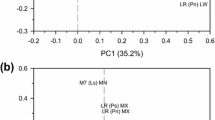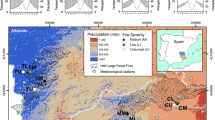Abstract
Key message
Minimum wood density is a proxy of soil moisture during the early growing season. Maximum wood density responds to late growing-season drought.
Abstract
Seasonally dry areas are ideal settings to refine our understanding of tree growth proxies of water availability. Despite recent methodological advances in quantitative wood anatomy and wood density, our knowledge of wood density responses to climate at intra-annual scales in seasonal drought-prone regions is still limited. The objective of this study is to elucidate how minimum (MnD) and maximum (MxD) wood density respond to hydroclimate variability of two coexisting conifers growing in a moisture-stressed environment. We prepared wood samples to obtain MnD and MxD values in Pinus lumholtzii and Pinus durangensis trees co-occurring in a drought-prone site located in northern Mexico. MnD and MxD were correlated with temperature, water balance and a drought index considering the period 1970‒2013. The P. lumholtzii MnD negatively responded to growing-season water availability as indicated by the negative correlations with water balance, and considering short to mid-term droughts lasting from 2 to 8 months. Both species showed a decrease in MxD during the last 15 years associated to a rise in temperature and drier conditions. Winter-spring water balance was positively associated with MxD, but July water balance showed a negative correlation. Intra-annual density data can represent robust proxies of hydroclimate variability in similar seasonally dry areas. Specifically, MnD should be further investigated as a surrogate of water availability effects on earlywood during the early growing season.





Similar content being viewed by others
Data availability
All data generated or analyzed during this study will be made available upon request.
Code availability
We used freeware and open source software.
References
Adams D, Comrie A (1997) The North American Monsoon. Am Meteorol Soc 78:2197–2213. https://doi.org/10.1175/1520-0477(1997)078%3c2197:TNAM%3e2.0.CO;2
Allen CD, Breshears DD, McDowell NG (2015) On underestimation of global vulnerability to tree mortality and forest die-off from hotter drought in the Anthropocene. Ecosphere 6:1–55. https://doi.org/10.1890/ES15-00203.1
Arzac A, Rozas V, Rozenberg P, Olano JM (2018) Water availability controls Pinus pinaster xylem growth and density: a multi-proxy approach along its environmental range. Agric For Meteorol 250:171–180
Belokopytova LV, Babushkina EA, Zhirnova DF, Panyushkina IP, Vaganov E (2019) Pine and larch tracheids capture seasonal variations of climatic signal at moisture-limited sites. Trees 33:227–242
Björklund J, Seftigen K, Schweingruber F, Fonti P, von Arx G, Bryukhanova MV, Cuny HE, Carrer M, Castagneri D, Frank DC (2017) Cell size and wall dimensions drive distinct variability of earlywood and latewood density in Northern Hemisphere conifers. New Phytol 216:728–740. https://doi.org/10.1111/nph.14639
Bouriaud O, Leban J-M, Bert D, Deleuze C (2005) Intraannual variations in climate influence growth and wood density of Norway spruce. Tree Physiol 25:651–660
Britez MRD, Sergent AS, Meier AM, Bréda N, Rozenberg P (2014) Wood density proxies of adaptive traits linked with resistance to drought in Douglas fir (Pseudotsuga menziesii (Mirb.) Franco). Trees 28:1289–1304
Brodribb TJ, Powers J, Cochard H, Choat B (2020) Hanging by a thread? Forests and drought. Science 368:261–266
Bryukhanova M, Fonti P (2013) Xylem plasticity allows rapid hydraulic adjustment to annual climatic variability. Trees 27:485–496
Camarero JJ, Gutiérrez E (2017) Wood density of silver fir reflects drought and cold stress across climatic and biogeographic gradients. Dendrochronologia 45:101–112
Camarero JJ, Hevia A (2020) Links between climate, drought and minimum wood density in conifers. IAWA J. https://doi.org/10.1163/22941932-bja10005
Camarero JJ, Rozas V, Olano JM (2014) Minimum wood density of Juniperus thurifera is a robust proxy of spring water availability in a continental Mediterranean climate. J Biogeogr 41:1105–1114
Camarero JJ, Fernández-Pérez L, Kirdyanov AV, Shestakova TA, Knorre AA, Kukarskih VV, Voltas J (2017) Minimum wood density of conifers portrays changes in early season precipitation at dry and cold Eurasian regions. Trees 31:1423–1437
Cleaveland MK (1986) Climatic response of densitometric properties in semiarid site tree rings. Tree-Ring Bull 46:13–29
Cook ER, Kairiukstis LA (1990) Methods of dendrochronology. Applications in the Environmental Sciences. IIAS, Kluwer
Cook ER, Krusic P (2007) ARSTAN 44 A Tree-ring standardization program based on detrending and autoregressive time series modeling with interactive graphics https://www.ldeocolumbiaedu/tree-ring-laboratory/resources/software Accessed 23 Aug 2019
Correa-Díaz A, Gómez-Guerrero A, Vargas-Hernández JJ, Rozenberg P, Horwath WR (2020) Long-term wood micro-density variation in alpine forests at central México and their spatial links with remotely sensed information. Forests 11:452
Cuny HE, Rathgeber CB, Frank D, Fonti P, Fournier M (2014) Kinetics of tracheid development explain conifer tree-ring structure. New Phytol 203:1231–1241
De Micco V, Carrer M, Rathgeber CBK, Camarero JJ, Voltas J, Cherubini P, Battipaglia G (2019) From xylogenesis to tree rings: wood traits to investigate tree response to environmental changes. IAWA J 40:155–182. https://doi.org/10.1163/2294193240190246
Domec JC, Gartner BL (2002) How do water transport and water storage differ in coniferous earlywood and latewood? J Exp Bot 53:2369–2379
Eilmann B, Zweifel R, Buchmann N, Fonti P, Rigling A (2009) Drought-induced adaptation of the xylem in Scots pine and pubescent oak. Tree Physiol 29:1011–1020
Falster DS, Warton DI, Wright IJ (2006) SMATR: standardised major axis tests and routines, version 2.0. http://www.bio.mq.edu.au/ecology/SMATR. Accessed 7 Sept 2020
Fritts HC (2001) Tree Rings and Climate. Blackburn, Caldwell
González-Cásares M, Pompa-García M, Camarero JJ (2017) Differences in climate-growth relationship indicate diverse drought tolerances among five pine species coexisting in Northwestern Mexico. Trees 31:531–544
González-Cásares M, Camarero JJ, Colangelo M, Rita A, Pompa-García M (2019a) High responsiveness of wood anatomy to water availability and drought near the equatorial rear edge of Douglas-fir. Can J For Res 49:1114–1123. https://doi.org/10.1139/cjfr-2019-0120
González-Cásares M, Pompa-García M, Venegas-González A (2019b) Climate signals from intra-annual wood density fluctuations in Abies durangensis. IAWA J 40:276–287
González-Cásares M, Pompa-García M, Venegas-González A, Domínguez-Calleros P, Hernández-Díaz J, Carrillo-Parra A, González-Tagle M (2019c) Hydroclimatic variations reveal differences in carbon capture in two sympatric conifers in northern Mexico. PeerJ 7:e7085
González-Elizondo MS, González-Elizondo M, Tena-Flores JA, Ruacho-González L, López-Enríquez IL (2012) Vegetación de la Sierra Madre Occidental, México: Una síntesis. Acta Botánica Mexicana 100:351–403
Griffin D, Woodhouse CA, Meko DM, Stahle DW, Faulstich HL, Leavitt SW (2013) North American monsoon precipitation reconstructed. Geophys Res Lett 40:954–958. https://doi.org/10.1002/grl.50184
Hammer Ø, Harper DAT, Ryan PD (2001) PAST: paleontological statistics software package for education and data analysis. Palaeontol Electr 4:9
Hargreaves GH, Samani ZA (1982) Estimating potential evapotranspiration. J Irrig Drain Eng 108:225–230
Harris I, Osborn TJ, Jones P, Lister D (2020) Version 4 of the CRU TS monthly high-resolution gridded multivariate climate dataset. Sci Data 7:109
Holmes RL (1983) Computer-assisted quality control in tree-ring dating and measurement. Tree-Ring Bull 43:69–75
INEGI-Instituto Nacional de Estadística y Geografía (2005) Conjunto de datos vectoriales de la carta de climas escala 1:1000000. https://www.inegi.org.mx/temas/climatologia/. Accessed 08 March 2020
Martinez-Meier A, Sanchez L, Pastorino M, Gallo L, Rozenberg P (2008) What is hot in tree rings? The wood density of surviving Douglas-firs to the 2003 drought and heat wave. For Ecol Manag 256:837–843. https://doi.org/10.1016/j.foreco.2008.05.041
Muller-Landau HC (2004) Interspecific and inter-site variation in wood specific gravity of tropical trees. Biotropica 36:20–32
Nabais C, Hansen JK, David-Schwartz R, Klisz M, López R, Rozenberg P (2018) The effect of climate on wood density: what provenance trials tell us? For Ecol Manag 408:148–156
Pacheco A, Camarero JJ, Pompa-García M, Battipaglia G, Voltas J, Carrer M (2020) Growth, wood anatomy and stable isotopes show species-specific couplings in three Mexican conifers inhabiting drought-prone areas. Sci Tot Environ 698:134055
Pompa-García M, Venegas-González A (2016) Temporal variation of wood density and carbon in two elevational sites of Pinus cooperi in relation to climate response in northern Mexico. PLoS ONE 11(6):e0156782. https://doi.org/10.1371/journal.pone.0156782
Pompa-García M, Miranda-Aragón L, Aguirre-Salado CA (2015) Tree growth response to ENSO in Durango, Mexico. Int J Biom 59:89–97
Pompa-García M, Venegas-González A, Albiero Junior A, Sigala-Rodríguez JA (2018) Dendroecological approach to assessing carbon accumulation dynamics in two Pinus species from northern Mexico. Tree-Ring Res 74:196–209
Ramananantoandro T, Ramanakoto MF, Rajoelison GL, Randriamboavonjy JC, Rafidimanantsoa HP (2016) Influence of tree species, tree diameter and soil types on wood density and its radial variation in a mid-altitude rainforest in Madagascar. Ann For Sci 73:1113–1124. https://doi.org/10.1007/s13595-016-0576-z
Rathgeber CB (2017) Conifer tree-ring density inter-annual variability-anatomical, physiological and environmental determinants. New Phytol 216:621–625. https://doi.org/10.1111/nph.14763
Schuldt B, Knutzen F, Delzon S, Jansem S, Muller-Haubold H, Burltett R et al (2016) How adaptable is the hydraulic system of European beech in the face of climate change-related precipitation reduction? New Phytol 210:433–458
Schweingruber FH (1996) Tree rings and environment: dendroecology. Haupt, Bern
Seager R, Ting M, Davis M, Cane M, Naik N, Nakamura J, Li C, Cook E, Stahle D (2009) Mexican drought: an observational modeling and tree ring study of variability and climate change. Atmósfera 22:1–31
Sokal RR, Rohlf FJ (1995) Biometry: the principles and practice of statistics in biological research. Freeman, New York
Stahle DW, Cook ER, Burnette DJ, Villanueva J, Cerano J, Burns JN et al (2016) The Mexican Drought Atlas: Tree-ring reconstructions of the soil moisture balance during the late pre-Hispanic, colonial, and modern eras. Quat Sci Rev 149:34–60
Torbenson MCA, Stahle DW, Villanueva Díaz J, Cook ER, Griffin D (2016) The relationship between earlywood and latewood ring-growth across North America. Tree-Ring Res 72:53–66
Vaganov EA, Hughes MK, Shashkin AV (2006) Growth dynamics of conifer tree rings: images of past and future environments. Springer, Berlin
Vicente-Serrano SM, Beguería S, López-Moreno JI (2010) A multiscalar drought index sensitive to global warming: the Standardized Precipitation Evapotranspiration Index. J Clim 23:1696–1718
Villanueva-Díaz D, Stahle DW, Cleaveland MK, Therrell MD (2000) Estado actual de la dendrocronología en México. Cienc For 25:5–36
Villanueva-Díaz J, Cerano-Paredes J, Stahle DW, Luckman BH, Therrell MD, Cleaveland MK (2006) The climatic response of tree-ring chronologies in the Sierra Madre Occidental, Mexico. In: Symposium on Climate Change: Organizing the Science in the American Cordillera (Mendoza, Argentina), pp 91–92
Warton DI, Wright IJ, Falster DS, Westoby M (2006) Bivariate line-fitting methods for allometry. Biol Rev 81:259–291
Williams AP, Allen CD, Macalady AK, Griffin D, Woodhouse CA, Meko DM, Swetnam TW, Rauscher SA, Seager R, Grissino-Mayer HD, Dean JS, Cook ER, Gangodagamage C, Cai M, McDowell NG (2012) Temperature as a potent driver of regional forest drought stress and tree mortality. Nat Clim Change 3:292–297
Acknowledgments
We thank DendroRed (https://dendrored.ujed.mx) and Ejido “Papajichi”, Guachochi, Chihuahua. We thank the comments of several anonymous reviewers which improved a previous version of the manuscript.
Funding
Funding to MPG, AH and JJC was provided, respectively by: Mexican CONACYT A1-S-21471 project, PinCaR project (UHU-1266324, FEDER Funds, Andalusia Regional Government, Consejería de Economía, Conocimento, Empresas y Universidad 2014–2020) and FORMAL project (RTI2018-096884-B-C31, Spanish Ministry of Science).
Author information
Authors and Affiliations
Corresponding author
Ethics declarations
Conflict of interest
The authors declare that they have no conflict of interest.
Additional information
Communicated by Porth.
Publisher's Note
Springer Nature remains neutral with regard to jurisdictional claims in published maps and institutional affiliations.
Electronic supplementary material
Below is the link to the electronic supplementary material.
Rights and permissions
About this article
Cite this article
Pompa-García, M., Hevia, A. & Camarero, J.J. Minimum and maximum wood density as proxies of water availability in two Mexican pine species coexisting in a seasonally dry area. Trees 35, 597–607 (2021). https://doi.org/10.1007/s00468-020-02062-y
Received:
Accepted:
Published:
Issue Date:
DOI: https://doi.org/10.1007/s00468-020-02062-y




